Community forms in many different ways. The bond can be based on geographic location or shared interests, but at other times, community forms out of friendship, common interests, or even necessity. There are even moments in which disaster strikes, and a temporary community forms with all members focused simply on survival. The ties that bind those temporary community members briefly may be just as strong as some lifelong connections.
Building a caring community is an important part of teaching in today’s world. For this reason, members of the Children’s Literature and Reading Special Interest Group focus on multiple types of community for this week’s book reviews.
Grades K-3
Amado, Elisa. (2014). Why are you doing that? Illus. by Manuel Monroy. Toronto, ON: Groundwood Books.
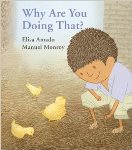 The ever-curious Chepito is sure to remind some readers of their own irrepressible children. From the moment he awakens, the young boy questions everyone he encounters about the reasons for their actions. Each person, from his mother to a neighbor lying beneath a banana tree, takes the time to explain how his/her actions eventually lead to good food for Chepito to eat. As he observes the care with which each person treats the animals and crops, he is reminded of good stewardship.
The ever-curious Chepito is sure to remind some readers of their own irrepressible children. From the moment he awakens, the young boy questions everyone he encounters about the reasons for their actions. Each person, from his mother to a neighbor lying beneath a banana tree, takes the time to explain how his/her actions eventually lead to good food for Chepito to eat. As he observes the care with which each person treats the animals and crops, he is reminded of good stewardship.
This simple title provides excellent information about how we get our meals, knowledge that is becoming more essential in a world filled with fast food. The lively digital illustrations originated as drawings created with color pencil and watercolor.
-Barbara A. Ward, Washington State University Pullman
Sadler, Marilyn. (2014). Alice from Dallas. Illus. by Ard Hoyt. New York, NY: Harry N. Abrams.
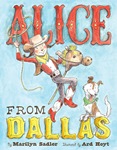 Alice from Dallas prides herself on being a cowgirl. But she’s a tad insecure about her knowledge about the subject since she’s actually from Dallas, Pennsylvania. Maybe she isn’t the real deal, after all, since Pennsylvania is far from where cowgirls love to roam. When Lexis from Texas arrives at school, Alice realizes that she has some competition. All of their classmates hang on every word Lexis utters and enjoy doing what she does. After all, she's a real cowgirl. A showdown between the two girls has unexpected results, and Alice later learns the truth about her rival and her own origin.
Alice from Dallas prides herself on being a cowgirl. But she’s a tad insecure about her knowledge about the subject since she’s actually from Dallas, Pennsylvania. Maybe she isn’t the real deal, after all, since Pennsylvania is far from where cowgirls love to roam. When Lexis from Texas arrives at school, Alice realizes that she has some competition. All of their classmates hang on every word Lexis utters and enjoy doing what she does. After all, she's a real cowgirl. A showdown between the two girls has unexpected results, and Alice later learns the truth about her rival and her own origin.
The text has a good message as Alice realizes that winning isn’t everything, and the illustrations, created with watercolor paints and finished in ink, are filled with action and show just how determined both girls are to stake their claims on the classroom territory. Can two rival cowgirls become friends? Readers will quickly find out.
-Barbara A. Ward, Washington State University Pullman
Smith, Alex T. (2014). Claude at the beach. Atlanta, GA: Peachtree Publishers.
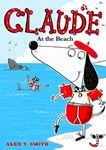 This bizarre but hilarious series about an adventuresome dog and his sock sidekick just keeps getting better, even while the two of them form their own little community. In this installment, Claude decides that he and Sir Bobblysock deserve a vacation. After packing his suitcase with a most unlikely assortment of things Claude thinks they'll need, the two friends head to the beach where they soak up the sun, save someone's life, encounter pirates, and find treasure.
This bizarre but hilarious series about an adventuresome dog and his sock sidekick just keeps getting better, even while the two of them form their own little community. In this installment, Claude decides that he and Sir Bobblysock deserve a vacation. After packing his suitcase with a most unlikely assortment of things Claude thinks they'll need, the two friends head to the beach where they soak up the sun, save someone's life, encounter pirates, and find treasure.
Upon their return from a hard day's work, their human companions have quite a surprise as they ponder what in the world has been going on while they’ve been away from home. After all, there must be a good explanation for finding sand in one's underwear.
-Barbara A. Ward, Washington State University Pullman
Wallace, Chad. (2014). The mouse and the meadow. Nevada City, CA: Dawn Publications.
 In a story told through rhyming text, a young mouse ventures forth into the meadow where he encounters friends and foes, including a honeybee, a caterpillar, a box turtle, a snake, and a great horned owl. The luminous illustrations are large, often allowing the intrepid adventurer and the creatures he encounters to be seen up close or at other times focusing on one part of an animal such as the snake's fangs or the owl's talons.
In a story told through rhyming text, a young mouse ventures forth into the meadow where he encounters friends and foes, including a honeybee, a caterpillar, a box turtle, a snake, and a great horned owl. The luminous illustrations are large, often allowing the intrepid adventurer and the creatures he encounters to be seen up close or at other times focusing on one part of an animal such as the snake's fangs or the owl's talons.
There is a lesson here about being ready for the challenges each day brings as well as an excellent introduction to the habitat and inhabitants of the meadow. Young readers will enjoy the book and the back matter that extends its content, making it a good choice for an elementary science class.
-Barbara A. Ward, Washington State University Pullman
Grades 4-6
Cutler, Jane. (2014). Susan Marcus bends the rules. New York, NY: Holiday House.
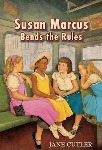 When WWII results in relocation from New York City to Clayton, Missouri for ten year old Susan Marcus and her family, Susan is heartsick about leaving everything and everyone familiar behind her. Things are different in her new home, and it's almost as though no one remembers that the war is even being fought. There seems to be little community since her neighbors make condescending remarks about New Yorkers. When Susan becomes friends with Loretta, an African-American girl who secretly lives in the same apartment building, she encounters prejudice toward the girl and learns first-hand about the restrictive Jim Crow laws.
When WWII results in relocation from New York City to Clayton, Missouri for ten year old Susan Marcus and her family, Susan is heartsick about leaving everything and everyone familiar behind her. Things are different in her new home, and it's almost as though no one remembers that the war is even being fought. There seems to be little community since her neighbors make condescending remarks about New Yorkers. When Susan becomes friends with Loretta, an African-American girl who secretly lives in the same apartment building, she encounters prejudice toward the girl and learns first-hand about the restrictive Jim Crow laws.
By the end of the book, she has encountered all manner of prejudice—toward blacks, Jews, New Yorkers, and the Japanese. Eventually, she and her neighbor Marlene concoct a plan in which the girls can spend some time together in public. The trip is eye-opening in many ways. For instance, the hatred of others toward all Asians is evident in the destruction of a neighborhood Chinese restaurant and the provocative messages left on the building where food is served. By the time the girls return from their brief trip, having bent a few rules, they are a little wiser but no less determined to create a more equitable community.
-Barbara A. Ward, Washington State University Pullman
Harper, Charise Mericle. (2014). Just Grace and the super sleepover. New York: Houghton Mifflin Harcourt Books for Young Readers.
 Just Grace loves birthday parties, but when she learns that her classmate has planned an outdoor overnight sleepover for her party, she grows surprisingly anxious about all the bugs and creepy crawlies that she may encounter. Through a series of events, she finds herself telling one lie after another, even to her best friend Mimi. As one lie begets another, several classmates are drawn into the mess she has inadvertently created, and Grace feels guilty and miserable.
Just Grace loves birthday parties, but when she learns that her classmate has planned an outdoor overnight sleepover for her party, she grows surprisingly anxious about all the bugs and creepy crawlies that she may encounter. Through a series of events, she finds herself telling one lie after another, even to her best friend Mimi. As one lie begets another, several classmates are drawn into the mess she has inadvertently created, and Grace feels guilty and miserable.
While the girls' teacher, Miss Lois, turns out to have some surprises up her sleeve as she shares her love for the good green earth with her students, Grace is preoccupied with figuring out how to fix things and stop having to tell even more lies. The book is filled with appealing illustrations and real-world dilemmas with which readers will relate.
-Barbara A. Ward, Washington State University Pullman
Kerley, Barbara. (2014). A home for Mr. Emerson. Illus. by Edwin Fotheringham. New York, NY: Scholastic.
 With quotes from Ralph Waldo Emerson on the endpapers and sprinkled throughout the story, this partial picture book biography introduces young readers to the influential author and philosopher. His book-filled Concord, Massachusetts, home became his refuge, and it became the stopping place for many visitors interested in chatting with the great thinker. When a fire destroys his home, he truly finds out the meaning of community and how much he means to his neighbors. When he returns from a trip abroad, his neighbors find a way to surprise him by replacing everything he thought he had lost.
With quotes from Ralph Waldo Emerson on the endpapers and sprinkled throughout the story, this partial picture book biography introduces young readers to the influential author and philosopher. His book-filled Concord, Massachusetts, home became his refuge, and it became the stopping place for many visitors interested in chatting with the great thinker. When a fire destroys his home, he truly finds out the meaning of community and how much he means to his neighbors. When he returns from a trip abroad, his neighbors find a way to surprise him by replacing everything he thought he had lost.
A gentle reminder of the importance of friends and one's community, the book contains digital media illustrations that are brimming with color and philosophical surprises.
-Barbara A. Ward, Washington State University Pullman
Grades 7-8
Angleberger, Tom. (2014). Princess Labelmaker to the rescue: An Origami Yoda book. New York, NY: Harry N. Abrams.
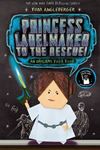 The battle wages on at McQuarry Middle School as the students fight against FunTime, the decidedly unentertaining test preparation program the school district has purchased. The administrators have done away with all electives and replaced them with drill-and-kill exercises in order to raise the school’s scores on the end-of-the-year state tests.
The battle wages on at McQuarry Middle School as the students fight against FunTime, the decidedly unentertaining test preparation program the school district has purchased. The administrators have done away with all electives and replaced them with drill-and-kill exercises in order to raise the school’s scores on the end-of-the-year state tests.
As is the case in the earlier titles in this series, the students draw their inspiration from origami puppets fashioned to resemble characters from Star Wars. In this installment, someone sends the crew's case file to Principal Rabbski to enlist her help. Up until this point, the students leading the rebellion against the tests and FunTime have considered her the enemy. Thus, the decision to share the case file with her is risky since it could result in her using the information against the Alliance. As is typical for this series, there are wonderful references to Star Wars characters, sayings, and plotlines.
There are plenty of surprises in this story about a student community formed to make changes in the school’s procedures. Could it be that the kids and their origami puppets will take on Washington, DC when they go on their field trip? Teachers (and students) across the nation have their fingers crossed that it might be so. Clearly, the high-stakes movement did not begin at McQuarry Middle School.
-Barbara A. Ward, Washington State University Pullman
Brown, Skila. (2014). Caminar. Somerville, MA: Candlewick Press.
 Guatemala has been rocked by internal unrest for three decades. This eloquently told story thrusts readers right into the heart of the conflict and violence which comes from unexpected sources—the country’s soldiers.
Guatemala has been rocked by internal unrest for three decades. This eloquently told story thrusts readers right into the heart of the conflict and violence which comes from unexpected sources—the country’s soldiers.
Carlos is an obedient young man who does what his mother says without thinking, which turns out to save his life. When the small village where he lives is visited by soldiers looking for recruits and a band of guerrillas looking for food, his mother unexpectedly sends Carlos into the woods for mushrooms. This action takes Carlos far from his village when the soldiers return. Although he clearly does not see what happened in the village, he knows the fate of his family and friends. The soldiers slaughter the villagers, and Carlos races up the mountain to warn those who live in his grandmother's village. Forced to become a man and rely on his instincts to save those around him, Carlos depends on nature and some guerillas he encounters to help him.
The author’s novel in verse format insures that she captures the emotions and rapid events of the time period. It's unlikely that most students have any idea that 200,000 individuals like those in Carlos’s village disappeared from Guatemala between 1960 and 1996.
-Barbara A. Ward, Washington State University Pullman
Burgan, Michael. (2014). Tank man: How a photograph defined China’s protest movement. Mankato, MN: Capstone/Compass Point Books.
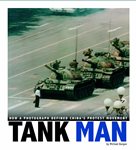 Filled with large photographs of a pivotal moment in Chinese history, this book describes how a photograph showing one man’s bravery brought hope to others. In 1987 several students protested the lack of democracy in China by gathering in Tiananmen Square. As the government grew weary of the continued protests that continued for months, soldiers were ordered to clear the area of protesters in 1989. Photographer Jeff Widener shot a photograph of one man in a white shirt standing alone against a column of tanks. Although no one knows who that man was or even what happened to him later, clearly he—and the famous photograph—represented the hope for freedom amid almost hopeless odds and military might.
Filled with large photographs of a pivotal moment in Chinese history, this book describes how a photograph showing one man’s bravery brought hope to others. In 1987 several students protested the lack of democracy in China by gathering in Tiananmen Square. As the government grew weary of the continued protests that continued for months, soldiers were ordered to clear the area of protesters in 1989. Photographer Jeff Widener shot a photograph of one man in a white shirt standing alone against a column of tanks. Although no one knows who that man was or even what happened to him later, clearly he—and the famous photograph—represented the hope for freedom amid almost hopeless odds and military might.
Part of the Captured World History series, this title offers much food for thought about what is worth sacrificing one’s life for and one individual’s courage in confronting those tanks.
-Barbara A. Ward, Washington State University Pullman
Muten, Burleigh. (2014). Miss Emily. Illus. by Matt Phelan. Somerville, MA: Candlewick Press.
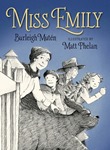 Youngsters today often hear stories of the reclusive nature of Emily Dickinson, arguably the best known American female poet. But it only takes a little research to realize that while she might not have sought out society, she enjoyed adventures and the companionship of others. This slim volume describes an evening excursion in Amherst on which she led three neighborhood children. Since the circus was coming to town, she decided that they simply had to watch as its cars unloaded their exotic wares.
Youngsters today often hear stories of the reclusive nature of Emily Dickinson, arguably the best known American female poet. But it only takes a little research to realize that while she might not have sought out society, she enjoyed adventures and the companionship of others. This slim volume describes an evening excursion in Amherst on which she led three neighborhood children. Since the circus was coming to town, she decided that they simply had to watch as its cars unloaded their exotic wares.
In order to keep others from recognizing them during their adventure, Miss Emily and the children dress as gypsies and gain front-row seats on the action. The night’s adventure is told by Mac, the youngest child, who is also the son of the local minister. So strong is the bond among this small community that when Mac sprains his ankle, Miss Emily takes the blame. When Mac realizes that she relies on the youngsters to be her eyes and ears on new experiences, he and the others stage their very own version of what they saw at the circus just for her and her sister.
The text and lovely illustrations capture perfectly the awe inspired by the circus animals and their exotic trainers, not to mention the ever-fascinating personality of this poet who somehow found literary inspiration in the slugs found in her family’s garden.
-Barbara A. Ward, Washington State University Pullman
Philbrick, Rodman. (2014). Zane and the hurricane: A story of Katrina. New York, NY: Scholastic/The Blue Sky Press.
 Twelve-year-old Zane Dupree knows very little about his deceased father's family. When his mother makes contact with his great-grandmother and sends him to visit her in New Orleans, the timing couldn’t be worse. While he bonds quickly with Miss Trissy and tries to understand the ways of this strange city, things are about to get stranger still for Zane and his beloved dog Bandit.
Twelve-year-old Zane Dupree knows very little about his deceased father's family. When his mother makes contact with his great-grandmother and sends him to visit her in New Orleans, the timing couldn’t be worse. While he bonds quickly with Miss Trissy and tries to understand the ways of this strange city, things are about to get stranger still for Zane and his beloved dog Bandit.
The author does an admirable job of describing the hectic days before Hurricane Katrina's arrival as well as the rain, the wind, and the fast-rising waters that filled the bowl-shaped city that lies beneath sea level. As Zane ends up back in the Ninth Ward while the flood waters rise and is rescued by a kindly musician in a boat, he learns about what really matters. The book gives readers some idea of the confusion and paranoia that suffused the area during the disaster. Kudos go to the author for not claiming to have told the definitive story of Katrina, but only one of many stories from that storm and the community it tore apart.
-Barbara A. Ward, Washington State University Pullman
Grades 9-12
Demetrios, Heather. (2014). Something real. New York, NY: Henry Holt and Company.
 “Reality” shows seem to have captured the attention of most television viewers today. But how much reality do those programs actually show and how much is staged or scripted? Seventeen-year-old Bonnie Baker has spent almost her entire life being filmed as part of a reality show called Baker’s Dozen. The nation even watched when she was born and when she took an overdose of pills. After the show was cancelled four years ago, Bonnie changed her name to Chloe and tried to blend in with everyone else.
“Reality” shows seem to have captured the attention of most television viewers today. But how much reality do those programs actually show and how much is staged or scripted? Seventeen-year-old Bonnie Baker has spent almost her entire life being filmed as part of a reality show called Baker’s Dozen. The nation even watched when she was born and when she took an overdose of pills. After the show was cancelled four years ago, Bonnie changed her name to Chloe and tried to blend in with everyone else.
Just when she is feeling normal, to her surprise, her mother decides to resurrect the show, ostensibly to pay the bills and support the financial needs of the three oldest siblings who are heading off to college. Despite Bonnie/Chloe's expressed disinterest in the project, she fears ruining the family financially if she doesn’t participate. She also tries to nip in the bud a growing romance with a great guy, Patrick, since she is sure he won’t be able to handle all the publicity dating her will bring.
The author has created several likeable characters trying to survive almost unendurable attention and lack of privacy. The book raises quite a few questions about privacy and whether we become the images created for us or whether we create those images. Although the book is well written, it’s difficult to distinguish the younger siblings—maybe because they weren't important to the plot or maybe because there were just so many of them. When the entire nation thinks it’s a part of one’s community, that’s too much familiarity.
-Barbara A. Ward, Washington State University Pullman
These reviews are submitted by members of the International Reading Association's Children's Literature and Reading Special Interest Group (CL/R SIG) and are published weekly on Reading Today Online.
The CL/R SIG is accepting submissions to the fall 2014 edition of their journal, The Dragon Lode, through April 15, 2014. There is an open theme, and they invite manuscripts that explore contemporary issues and questions, genre study, literary theory, and research related to children's literature and reading. Manuscripts should be no longer than 20 double-spaced, typed pages. Use APA (6th edition) formatting. Author's name, affiliation, mailing address, telephone and fax numbers, and e-mail address should be on a separate cover page. Photos and illustrations should be sent as a separate jpeg file. Any reference to the author that would enable the reviewer to know the author's identity should not appear in the manuscript. Submit all manuscripts to: Dr. Ruth McKoy Lowery, Co-editor.
CL/R SIG will host a special session entitled Children's Literature: The Perfect Teachable Moment on Saturday, May 10 at 3:00 p.m. at the International Reading Association 59th Annual Conference in New Orleans. The session celebrates award-winning children's and young adult books and authors. Author Nancy Bo Flood is the keynote session speaker. Her work encompasses more than a dozen books. Her recent historical fiction "Warriors in the Crossfire" is set in Saipan during WWII, and was selected on the 2011 Notable Books for a Global Society (NBGS) list. The NBGS list represents selections and authors from all genres K-12, with a focus on understanding of and appreciation for the world's full range of diverse cultures, ethnic, and racial groups. The session will also include presentation of the 2014 Notable Books for a Global Society (NBGS) list by members of the selection committee. Visit http://www.iraconference.org to learn more about IRA 2014 or to register.